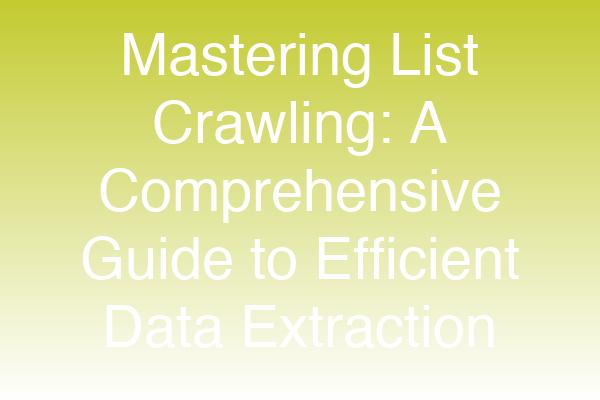
Categories: Data Science, Web Scraping, SEO
Tags: list crawling, web scraping, data extraction, SEO techniques, data analysis, automation, Python scraping
Introduction
In the digital age, data is the new oil. Businesses and researchers alike rely on effective data extraction techniques to gather valuable insights from the vast expanse of the internet. One such technique is list crawling, a method that allows users to extract structured data from websites efficiently. This article will delve deep into the concept of list crawling, its applications, techniques, and best practices to ensure you can harness its power for your data needs.
What is List Crawling?
List crawling is a specific type of web scraping that focuses on extracting data from lists found on web pages. These lists can be anything from product listings on e-commerce sites to directories of businesses or even lists of articles on blogs. The goal is to automate the process of gathering this information, making it easier to analyze and utilize.
Why is List Crawling Important?
List crawling is crucial for several reasons:
- Efficiency: Automates the data collection process, saving time and reducing manual effort.
- Accuracy: Minimizes human error in data entry and ensures consistent data collection.
- Scalability: Allows for the extraction of large datasets that would be impractical to gather manually.
Techniques for Effective List Crawling
To master list crawling, it's essential to understand the various techniques and tools available. Below are some of the most effective methods:
1. Using Python Libraries
Python is one of the most popular languages for web scraping due to its simplicity and powerful libraries. Here are a few libraries that can be particularly useful:
- Beautiful Soup: Great for parsing HTML and XML documents.
- Scrapy: An open-source framework for building web scrapers.
- Requests: Simplifies making HTTP requests.
Example Code Snippet
Here’s a simple example using Beautiful Soup to extract data from a list:
import requests
from bs4 import BeautifulSoup
url = 'https://www.omniparser.net/'
response = requests.get(url)
soup = BeautifulSoup(response.text, 'html.parser')
for item in soup.find_all('li'):
print(item.text)2. Utilizing Browser Automation Tools
For more complex sites that require interaction (like logging in), browser automation tools can be beneficial. Tools like Selenium allow you to control a web browser programmatically, making it easier to navigate through pages and extract data.
3. API Integration
Many websites offer APIs that provide structured data access. If available, using an API is often the most efficient and ethical way to gather data.
Best Practices for List Crawling
To ensure successful and ethical list crawling, consider the following best practices:
- Respect Robots.txt: Always check a website's
robots.txtfile to understand its crawling policies. - Rate Limiting: Avoid overwhelming a server by implementing rate limiting in your requests.
- Data Cleaning: Post-extraction, clean your data to ensure accuracy and usability.
Common Challenges in List Crawling
| Challenge | Description |
|---|---|
| Dynamic Content | Some sites load content dynamically using JavaScript, complicating extraction. |
| Anti-Scraping Measures | Websites may employ techniques to block scrapers, such as CAPTCHAs. |
| Legal and Ethical Issues | Always ensure compliance with legal standards and site terms of service. |
Expert Insights on List Crawling
Quote from Data Scientist, Jane Doe
"List crawling is not just about gathering data; it's about understanding the context and ensuring that the data you collect is actionable and relevant."
Quote from SEO Specialist, John Smith
"Effective list crawling can significantly enhance your SEO strategy by providing insights into competitor data and market trends."
FAQs About List Crawling
1. What is the difference between web scraping and list crawling?
Web scraping is a broader term that encompasses all types of data extraction from websites, while list crawling specifically refers to extracting data from lists.
2. Is list crawling legal?
While list crawling itself is not illegal, it’s essential to comply with a website's terms of service and respect their robots.txt file.
3. What tools are best for beginners in list crawling?
For beginners, Python libraries like Beautiful Soup and Scrapy are highly recommended due to their extensive documentation and community support.
Conclusion
List crawling is a powerful technique for data extraction that can greatly enhance your ability to gather and analyze information from the web. By understanding the tools and techniques available, as well as adhering to best practices, you can effectively harness this method for your data needs.
Call-to-Action
Are you ready to elevate your data extraction skills? Start your journey with our comprehensive tutorials on web scraping and list crawling today!
Social Media Snippet: Discover the power of list crawling! Learn techniques, best practices, and tools to efficiently extract data from the web in our latest guide. #DataScience #WebScraping
Suggested Internal Links:
- Understanding Web Scraping: A Beginner's Guide
- Top Python Libraries for Data Extraction
- How to Clean Your Data Post-Extraction
Suggested External Links:
Visual Content Suggestions:
- Infographic illustrating the list crawling process.
- Flowchart showing the steps involved in setting up a web scraper.
- Screenshots of code examples in action.
With this comprehensive guide on list crawling, you are now equipped to tackle your data extraction projects with confidence!